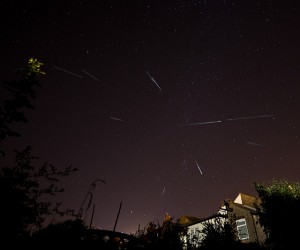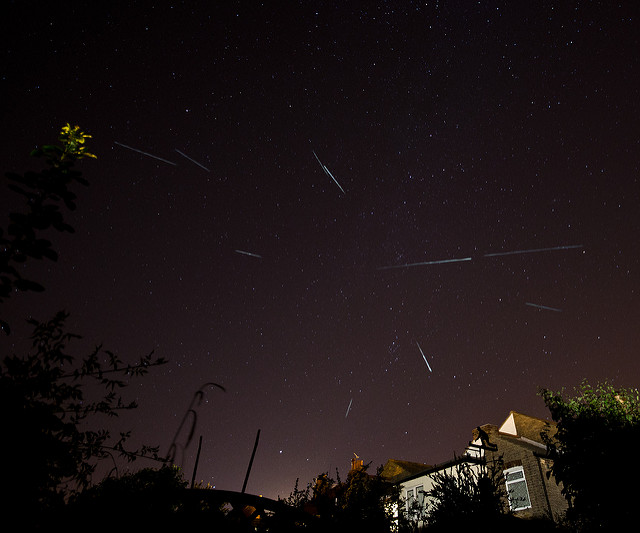WESTFIELD–As the Perseids meteor shower looms and is expected to be one of the best visual displays in recent memory, western Massachusetts could provide some great locations for people to watch–as long as the clouds cooperate.
The Perseids meteor shower happens annually as the Swift-Tuttle comet’s tail and the Earth’s orbit cross each other, causing debris from the tail to cut through the Earth’s atmosphere. This debris provides astronomy enthusiasts with a chance to see several meteors an hour soaring through the sky. This year though, viewers are being provided the opportunity to see upwards of a hundred or more an hour, and western Massachusetts provides several cities and towns to watch from.

This photo, “Perseids, 13 Aug 2013,” is from Flickr user the very honest man, and is under the Creative Commons License to be shared and/or adapted, even for commercial use
“They are predicting 150 to 200 meteors an hour, depending on who you’re listening to,” Kerrie McKinstry-Jett said. McKinstry-Jett is a visiting lecturer at Westfield State University, and has taught astronomy, physics and physical sciences at the university since 2007. McKinstry-Jett said that most often meteor showers produce just several meteors an hour, which makes this year’s Perseids meteor shower, which is so-named because the meteors’ radiant point–or perceived area of origination–the Perseus constellation, a unique event.
“The reason this one is supposed to be really good is because this particular section has been pulled on by Jupiter’s gravity and has been really condensed,” she said. “No cause for alarm, though–you’re probably not going to get hit in the head by a meteor.”
In fact, a person being struck by a meteorite is tremendously rare. How rare? The only person to ever be reportedly struck by a meteorite was Ann Hodges in Alabama in 1954. As she was napping on her couch, records say, a softball-sized meteorite came crashing through her ceiling, striking her radio, ricocheting off the appliance and into Hodge’s thigh.
And before you become too confused, a meteor and a meteorite are two different things. When debris comes through Earth’s atmosphere, this is a meteor. However, once that meteor reaches Earth and impacts with it, then it becomes a meteorite. These meteors can come from a variety of sources, whether it is planet, asteroid or, in the case of the Perseids meteor shower, a comet.
The Perseids meteor shower will have its peak viewing time on Aug. 12, in the early morning hours between midnight and 2 a.m. McKinstry-Jett said that experts are unsure when the showers will officially end, but they usually last for several days and are visible during the late evening and early morning hours.
McKinstry-Jett said that the best views of the meteor shower will be anywhere away from major cities, where the light pollution for them can interfere with viewing.
“Anywhere that is not right next to Springfield is pretty much a good place to see,” she said. “If you have a backyard and you’re living away from Springfield and have a low tree-line in the eastern direction you’re fine.”
She also suggested that if you have access to a hill or other elevated tract of land, this would improve the viewing experience. For more specific directions on where to go, McKinstry-Jett said that those who are interested can simply travel west on Route 20 or north on Interstate 91 and can find several places on the side of the road to watch from. Another option she said, is to head to the Littleville Dam in Huntington, where she said the university often takes its astronomy students for astronomical viewings.
As for weather, it will be warm in Westfield, near the mid-70s overnight until Saturday, when it drops to upper 60s for an overnight high. The cloud cover is projected to be in the 40 percent range tonight and Friday, which is fair for stargazing. However, Saturday is supposed to be poor for viewing, with 90 percent projected cloud cover and thunderstorms.
Regardless of where you are, McKinstry-Jett said to be safe. Bring a flashlight, a jacket or something to bundle up with in case you’re out in the cold and be sure that if you’re on the side of the road you aren’t in a spot where you can get struck by a passing vehicle. Ideally, she said, going to a town or city common is an smart and safe place to view.


